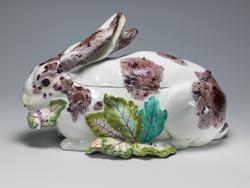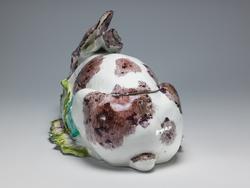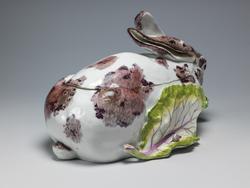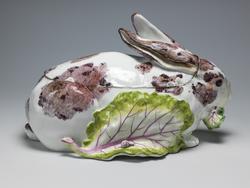Current Location: Gallery 26 (Lower Marlay)
Titles
Rabbit Tureen
Maker(s)
Factory:
Chelsea Porcelain Manufactory
Entities
Categories
Description
Soft-paste porcelain tureen in the form of a rabbit, painted naturalistically in polychrome enamels. The domesticated rabbit is crouching with a cabbage-leaf in its mouth, and other leaves on either side of it. There are snails on two of them.
Soft-paste porcelain, moulded in two halves (body and cover) painted overglaze in turquoise, several shades of green, yellow, red, purple, and several shades of brown enamel. The crouching domesticated rabbit is munching a cabbage leaf with a snail on it. Its fur is mainly white with large variegated brown patches here and there. On the rabbit''s right side there is a large cabbage leaf with a snail on it, and on the rabbit's left, a group of four cabbage leaves, and a different turquoise leaf.
Notes
History note: Unknown before donor, Mrs W.D. (Frances Louisa) Dickson, Bournemouth
Legal notes
Given by Mrs W.D. Dickson
Measurements and weight
Height: 22.2 cm
Length: 34.9 cm
Acquisition and important dates
Method of acquisition: Given
(1945-04-19)
by
Dickson, W. D. (Frances Louisa), Mrs
Dating
18th Century, Mid
George II
Red anchor period (1752-1756)
Production date:
circa
AD 1755
Note
Domesticated rabbits kept for food rather than as pets were common in the London area at that time, but the modeller of the tureen might have been influenced by a similar rabbit illustrated in Conrad Gesner's 'Historiae animalium' (Zurich 1551), book I, p. 394, which also appeared in English editions as Historie of foure-footed beastes in 1607 and 1658. Sir Hans Sloane, a resident of Chelsea from 1742, who died in 1753, owned copies of the 1551 and 1607 editions, now in the British Library.
Label text from the exhibition ‘Feast and Fast: The Art of Food in Europe, 1500–1800’, on display at The Fitzwilliam Museum from 26 November 2019 until 31 August 2020: Tureen and cover in the form of a rabbit Ceramic tableware in the form of edible animals, vegetables, and fruit was made for display and use. When placed on the dining table, it was intended to deceive, surprise, and amuse diners. Tureens like this were normally used for soup, served during the first course at dinner (the meal served in the middle of the day). While this tureen could have held rabbit soup, it could equally have been filled with another soup, for example, pea soup, which – to judge from the large number of published recipes – was one of the most popular soups in England at this time.
Porcelain and faïence tureens and covered dishes in the shape of animals,vegetables, and fruit for use and decoration on the dining table were fashionable throughout western Europe during the mid 18th century. This rabbit was made at the Chelsea Porcelain Manufactory established about 1744-5 by Nicholas Sprimont, a London silversmith, born in Liège. The factory made porcelain for the luxury market, selling its products through London warehouses, chinamen (and women) and its own annual sales held by Mr Ford. Several different animal tureens were mentioned in the sale catalogues of the 1755 and 1756 sales. A rabbit tureen is described on the twelfth day of the 1755 sale, 22nd March, as 'No 43 A very fine tureen, in the form of a RABBIT BIG AS LIFE in a fine oval dish. These large tureens were difficult to make and fire successfully in soft-paste porcelain, and often have firing cracks. Nor did they stand up well to having very hot liquids poured into them. As a result they appear to have been easily broken, and very few examples have survived. The Fitzwilliam's collection also includes a Chelsea hen and chickens tureen with its dish (C.3 & A & B-1958), a pair of fighting cocks (C.4.1 & A-1958 and C.4.2 & A-1958), and a carp on a dish (.C.36 & A-1932 and C.10-1963) The Chelsea factory also made smaller rabbits for use during the dessert course.
School or Style
Rococo
Components of the work
Decoration
composed of
enamels
( polychrome)
Materials used in production
presumed lead
Lead-glaze
Soft-paste porcelain
Techniques used in production
Glazing (coating)
: Soft-paste porcelain, painted in polychrome enamels
Inscription or legends present
- Text: an anchor
- Location: On the base
- Method of creation: Painted in red enamel
- Type: Factory mark
- Text: 2
- Location: On the base
- Method of creation: Painted in red enamel
- Type: Mark
References and bibliographic entries
Related exhibitions
Identification numbers
Accession number: EC.11 & A-1945
Primary reference Number: 131402
Stable URI
Audit data
Created: Saturday 6 August 2011
Updated: Friday 1 August 2025
Last processed: Friday 1 August 2025
Associated departments & institutions
Owner or interested party:
The Fitzwilliam Museum
Associated department:
Applied Arts
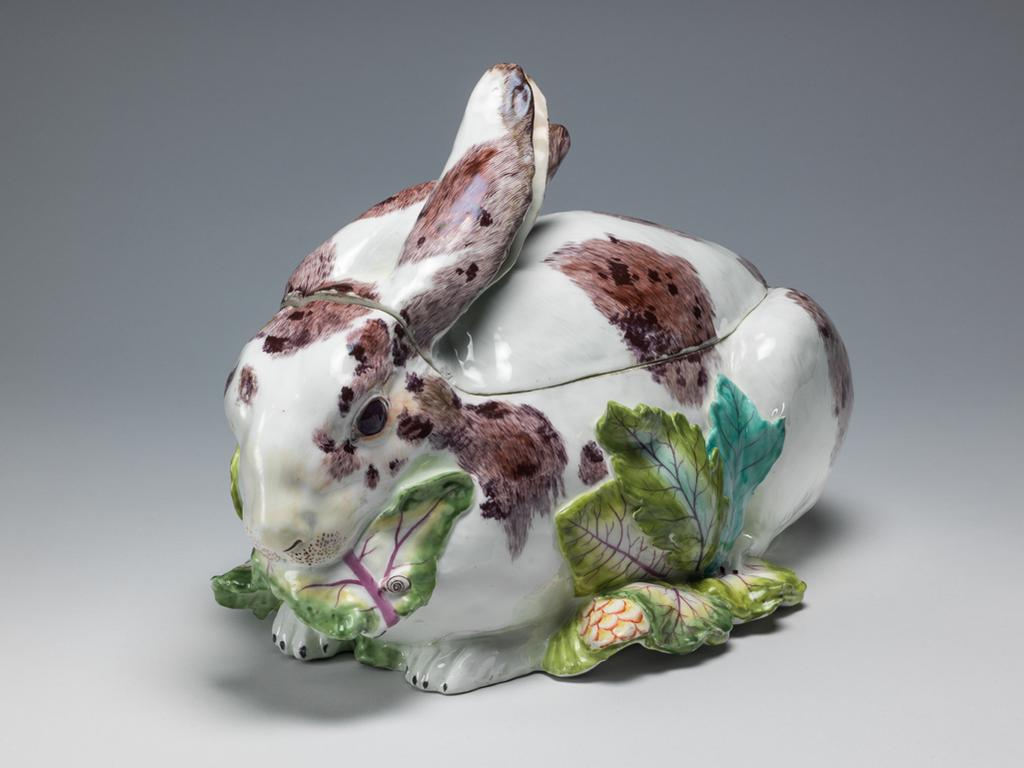
 IIIF Manifest
IIIF Manifest
